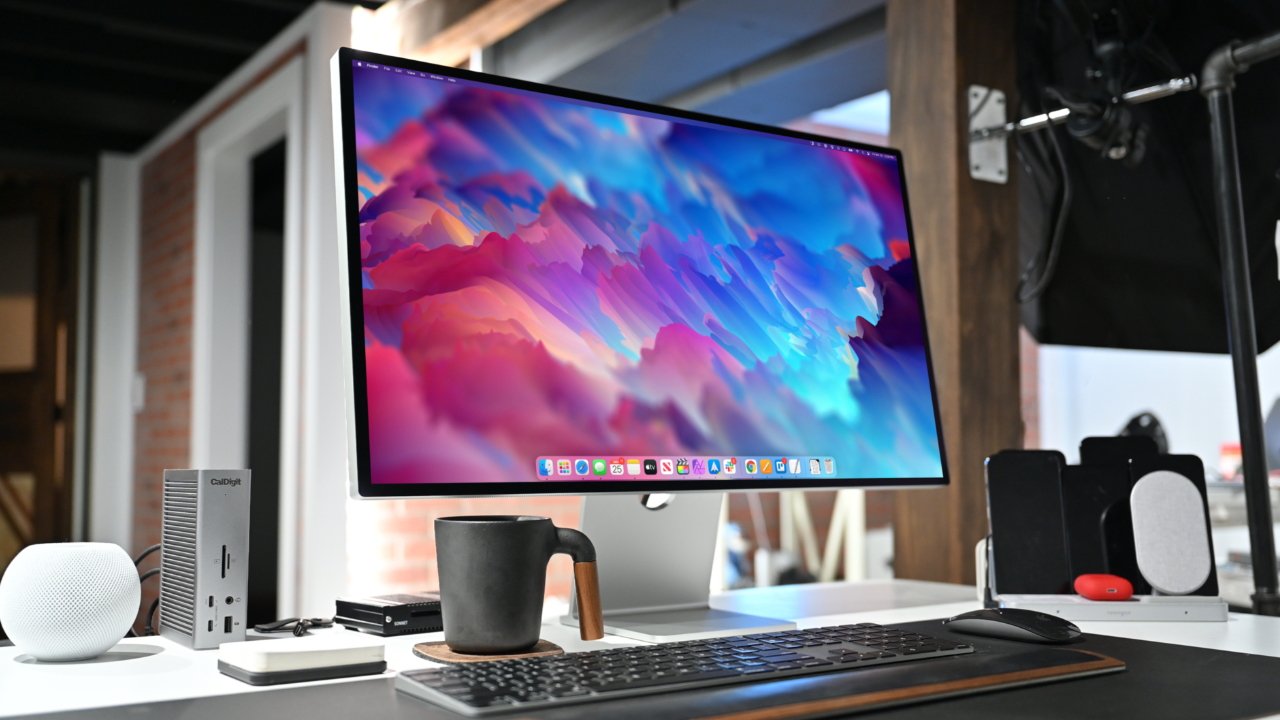Apple releases Studio Display firmware update 15.5 with speaker fault fix
The Studio Display has a new firmware update available that fixes intermittent speaker failure on some models.

The new firmware update may address speaker issues
Owners of the Studio Display can get the firmware version 15.5 by navigating to System Preferences on their connected Mac. Select "Software Update" to check if the update is available.
The update was released by Apple only three days after the company acknowledged a speaker fault in the Studio Display. Users were reporting issues of sound failing intermittently, and Apple called it a software problem.
Apple offered a workaround to temporarily fix the problem by cycling the display's power. Since there isn't a power button, that means users need to unplug the monitor then plug it back in.
According to the software release notes, the new update fixes the software issue that caused some Studio Display speakers to fail.
The Studio Display has an A13 Bionic processor, and it seems to run a variation of iOS. Firmware version 15.5 has a build number 19F80, which is only a few digits higher than the iOS 15.5 build of 19F77.
Update 2:40 p.m. Eastern: Updated with details about the speaker fault fix
Read on AppleInsider

The new firmware update may address speaker issues
Owners of the Studio Display can get the firmware version 15.5 by navigating to System Preferences on their connected Mac. Select "Software Update" to check if the update is available.
The update was released by Apple only three days after the company acknowledged a speaker fault in the Studio Display. Users were reporting issues of sound failing intermittently, and Apple called it a software problem.
Apple offered a workaround to temporarily fix the problem by cycling the display's power. Since there isn't a power button, that means users need to unplug the monitor then plug it back in.
According to the software release notes, the new update fixes the software issue that caused some Studio Display speakers to fail.
The Studio Display has an A13 Bionic processor, and it seems to run a variation of iOS. Firmware version 15.5 has a build number 19F80, which is only a few digits higher than the iOS 15.5 build of 19F77.
Update 2:40 p.m. Eastern: Updated with details about the speaker fault fix
Read on AppleInsider

Comments
https://wallpaperaccess.com/colorful-clouds#google_vignette
It's the 8th one down the page.
or attached here for your convenience:
1. Do you know what, in entirety, iOS does for this display? It may sound counterintuitive that a display needs an OS to operate but, as we know, Apple makes choices for such things for a reason. To describe it as "hobbled" suggests it's something designed to limit its functionality. But that isn't the case, is it? But you'd be correct if you suggested that Apple needed to do more to ensure the software wasn't buggy before release. But that's something different that "hobbled" wouldn't you say?
2. Plagued suggests wide-spread. There were issues with the software that controlled the camera. Fixing the software corrected those issues. This means the camera hardware wasn't at fault. To describe the problem as "Lousy hardware camera" is not factual.
3. My display wasn't bricked with the first firmware update. Most weren't. To describe it as you did suggests it happened consistently and all the time. Again, that's not factual.
4. The speakers didn't fail. The software allowing the computer to communicate with the display speakers was faulty, requiring a disconnect and reboot to resolve the problem. Yes, a power button would have made the power-down and reboot easier. Is that necessarily a reason to add hardware to the display? Just in case at some point there's a software glitch that needs to be reset? Debatable. In this case, from a simplicity and design standpoint, it actually doesn't make sense to build in hardware for the possible need of a reboot. The fault here is in the software/firmware which should absolutely have been perfected prior to release.
5. This was absolutely lousy quality control. However, it's lousy software quality control, which is easily correctable. Lousy hardware quality control would be an entirely different matter. Keep in mind, as with Tesla, software on technology like this means the possibility of new features being enabled in the future. Who knows. As mentioned, Apple has a reason for most things. You may or may not agree with those reasons but that doesn't mean those reasons don't exist or aren't valid.
By the way, I encountered the sound issue for the first time just last week. Audio would play for a second or two and then stop. I'd go to a different app or file and audio would play and then stop. To discover that a simple unplugging and reconnecting would resolve the issue meant a pretty simple fix and knowing it was a known issue meant knew a fix was coming. I could have chosen to be really pissed with the inconvenience of having to unplug my display and while annoying, it really isn't a big deal. A week later, a software fix was released. I would have been happier if the software engineers were more careful to ensure these bugs didn't exist in the first place and I'd agree this doesn't look great for a big company like Apple to allow simple glitches to be released. Mistakes happen. The fact it was promptly addressed, to me, was the important part.
We should all call out Apple for these mistakes. But if you're gonna criticise, at least focus on the problems. Blowing your criticisms out of proportion makes you sound like you're on a mission to bash the company and actually delegitimises your arguments. It makes it incredibly hard to take you seriously.